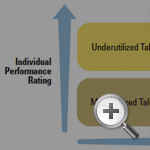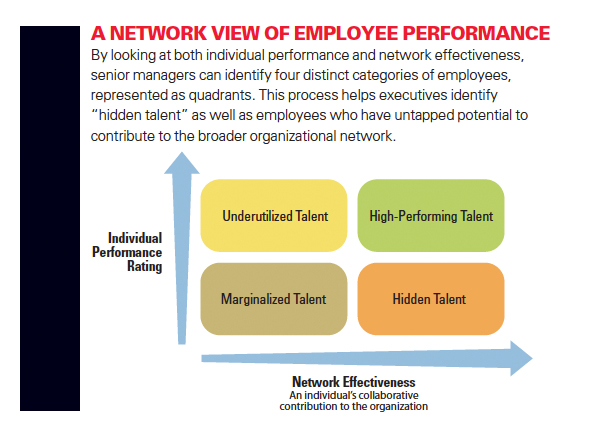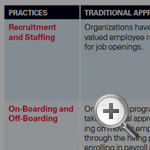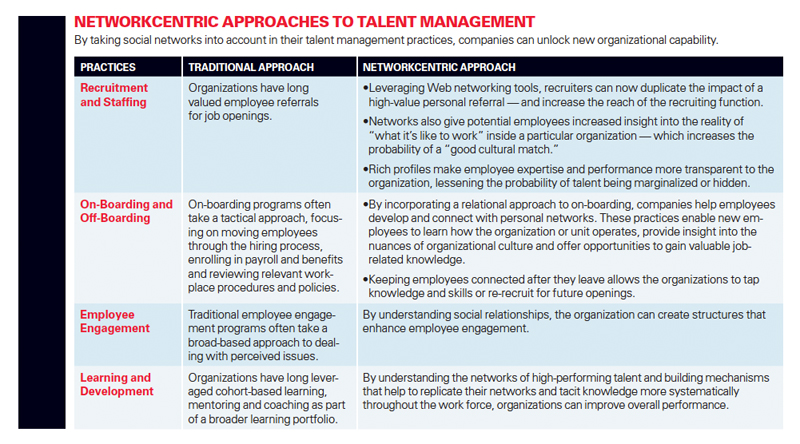Building a Well-Networked Organization
By understanding the structure of talent networks within companies, managers can foster more effective collaboration.
Topics
Social Business

The design company IDEO, whose IDEO Method Cards are pictured here, uses a social platform to facilitate staffing of projects.
Image courtesy of IDEO.
Leaders and human resources professionals are searching for ways to generate more value from their employees. Finding new approaches for optimizing talent is a critical aspect of organizational performance. The Hackett Group, an operations improvement consulting firm, recently found that organizations that excel at talent management increased earnings by nearly 18% and improved operational and process performance.1 Similarly, Towers Watson, a leader in human resources consulting, reported that companies with integrated talent management programs that were aligned with business strategy and operations were significantly more likely to be high-performing organizations.2
Organizations could get even more from their investments in talent management if they focused on collaboration — a critical component of employees’ effectiveness. An IBM survey recently found that high-performing organizations (as measured by earnings before interest, taxes, depreciation and amortization) are 57% more likely than other companies to provide their global teams with collaborative and social networking tools.3 McKinsey & Company, too, found that well-networked organizations delivered higher market share and profits than less-networked companies.4
Senior executives would do well to give as much thought to the design, development and facilitation of networks as they historically have given to organizational structure and reporting relationships. But this is not easy to do. Job design and performance management, for example, are often based on individual accountability despite the fact that most work today is collaborative. By the same token, work flows and decision processes are not typically designed to reflect the collaborative nature of work and innovation. And talent management practices usually focus on individual competencies and experiences, while overlooking the critical importance of an employee’s networks.
We set out to examine how talent practices can improve collaboration in organizations by examining what companies were already doing to enhance collaboration and informal networks through talent management processes such as recruiting, on-boarding, engagement, staffing, succession planning, knowledge management and training. Using a multi-pronged approach, we conducted an online survey of talent practices, interviewed talent experts and used publicly available material to identify specific networkcentric practices. (See “About the Research.”) We also conducted a set of in-depth case studies using a technique called organizational network analysis (ONA) to expand our knowledge of how networks impact performance and to understand the behavior of top performers. Our goal was to establish a road map for leaders and human resource professionals interested in building collaborative enterprises through talent management.
Visualizing Talent in Social Networks
At a unit level, leaders need to be aware of how collaboration takes place among top performers and key experts and ways to make informal networks more effective than the sum of individual employee contributions. To appreciate how groups work, managers need to know who works with whom and how particular members collaborate with their colleagues, both near and far, to get things done. Groups come in all sizes and shapes. They can be a handful of senior managers and a few supporting players; multifunctional distributed teams with a few dozen or a few hundred people; or a division or function within a company with thousands of employees. On the one hand, an organizational network analysis can help managers see the specific kinds of relationships and collaborations (for example, mentorships, best-practice sharing or client introductions) that enable employees to become more effective. On the other hand, it can highlight high performers who, for one reason or another, aren’t providing as much leverage to the organization as they could.
By examining the individual performance data available in the organization’s human resource system together with the network results gained through an organizational network analysis, senior executives have an opportunity to consider the role of talent on two important dimensions. First, they can look at the performance of their individual employees, as many organizations do for the purpose of succession or work force planning. Then, by overlaying performance data with a network view, they can examine the same employees in terms of their broader collaborative contributions to the organization. This second dimension helps executives identify which employees are extensively leveraged and which employees have untapped potential to contribute to the broader network. When we examine talent along both dimensions, we find that there are four general categories of employees: high-performing talent; marginalized talent; hidden talent; and underutilized talent. (See “A Network View of Employee Performance.”) This framework shows managers where they have opportunities to improve both individual and organizational performance through networkcentric talent management.
High-performing talent We have studied the behavior of high-performing employees in a wide range of organizations over many years. Typically, these individuals rank in the top 20% of their organization based on the individual performance data available within their human resource systems. They tend to excel individually while at the same time developing, leveraging and contributing to their networks and those of selected others within or outside their organization. Early in their employment in organizations, high performers invest in, develop and renew high-quality network relationships. These personal relationships help them extend their expertise and avoid learning biases by tapping into pockets of knowledge and accessing valuable resources across their networks. High-performing employees often maintain memberships in multiple professional or technical communities, enabling them to translate values and move knowledge across various organizational boundaries.
In contrast to other employees, high performers tend to think strategically about personal relationships, positioning themselves at key leverage points within organizational networks. In doing so, they are more effective and also more visible, both within and outside their organization. This visibility tends to position them better than colleagues for plum assignments, development opportunities and promotions. High performers also maintain a healthy balance between what they ask for and what they contribute to their network relationships, allowing them to achieve personally while adding value to the organization.
Marginalized talent Employees who score low on both individual performance and network contributions fall into the category we call “marginalized talent.” Included in this segment are low performers, technical experts and young professionals who are bent on proving their brilliance but who don’t realize they need to collaborate and build effective personal networks inside and outside their organization. We’ve found that the effectiveness of marginalized employees can often be improved through either performance management processes or individual development plans that create an informal network connecting them to critical organizational segments. In our experience, helping poor performers see the effects that their lack of a balanced informal network can have is more motivating than simply urging them to collaborate with strangers or build large personal networks.
The Leading Question
How can companies leverage employee networks to increase individual and organizational performance?
Findings
- Look at employees from both individual performance and network effectiveness perspectives to identify valuable pockets of hidden talent.
- Develop talent management practices that incorporate and strengthen social networks.
- Create mechanisms to replicate the types of networks high performers have.
Apart from the role of an individual’s performance, network analysis shows that the relational and cultural dynamics of an organization can actually create poor performers. For example, well-connected people in networks can influence a new employee’s subjective views as well as his or her project opportunities. The network view lets you see which employees are different from the most central employees due to their job descriptions and other factors such as gender, ethnicity or tenure; it may reveal that some employees aren’t getting the recognition or the opportunities they need to succeed. These types of differences can make otherwise talented people marginal players within the organization. Once marginalized individuals are identified, managers can design recruitment, retention and development programs to effectively tie them to the network.
Hidden talent In addition to employees who are marginalized, there are surprisingly large numbers of employees in organizations who don’t register on management’s radar. We call such employees “hidden talent.” Although they may make significant contributions to their colleagues in ways that benefit the organization, they don’t appear on the top talent lists and usually aren’t considered for promotions or plum project assignments. Across a range of global organizations with well-regarded talent programs, we consistently find that this category is much larger than leaders realize. When we compare our list of a company’s top connectors (highly collaborative employees supporting the work and enabling the success of many others, based on an organizational network analysis) with management’s top talent list, we typically see an overlap of only 30% to 40%.
There are several explanations for this. In some cases, corporate management processes are too focused on individuals and do not acknowledge or account for collaborative work. In other instances, managers in positions of influence pick their favorites too quickly. Research shows that when leaders are not well positioned to “accurately observe” collaborative behavior,5 the impact of strong collaborators can remain hidden from them. In general, people know their personal networks but have a very limited knowledge of the personal networks of others. Additional reasons why talent remains hidden are more tied to the behavior of the employees; oftentimes, those employees don’t want to manage up, or individuals simply don’t understand the importance of making their contributions to the network transparent.
Regardless of the underlying driver, organizations must pay greater attention to hidden talent because of the potential impact on performance. Furthermore, the longer hidden talent goes unrecognized, the more likely individuals are to leave, thereby weakening the productivity of the broader network. Losing hidden talent can undermine collaborations that generate revenue, efficiencies or key innovations in ways that don’t necessarily appear on budget reports but have a real and devastating impact on the organization. By using a range of talent practices — including performance management, succession planning, employee development and knowledge management — organizations can work to identify, leverage and retain hidden talent.
Underutilized talent Finally, many organizations have a surprisingly large group of employees who are in the top performance category but who make relatively little collaborative contribution. In some cases, this is both appropriate and deliberate. For example, it’s common for companies to limit the amount of time scientists and engineers spend in meetings and committee work; making modest changes in the way they collaborate can keep critical talent focused while adding to knowledge flow in the network. In many cases, companies also try to accommodate employees attempting to balance work/life issues. Policies that allow such employees to dial up or dial down the level of their activities can help companies retain talent, and well-developed social networks help employees to remain connected with the organization as they move through career transitions, which can prove beneficial to a company.
Unfortunately, the number of employees who don’t fully engage in collaborative activity but should is large enough to create a performance drain in most organizations. Within organizations we studied, roughly 25% of the peripheral people in a given network fit this description; they learned how to game the system to achieve strong personal results, but their collaborative contributions — for example, introducing colleagues to clients, cross-selling and developing junior talent — were minimal or nonexistent. Such employees are frequently found in high-bonus environments that emphasize metrics based on individual performance. Performance management systems that promote collaborative behaviors together with individual performance can help organizations get more from these individuals.
Networkcentric Talent Practices
Social networks by themselves are not inherently valuable. But when carefully tied into talent processes, they can significantly influence individual and organizational performance. To identify networkcentric talent practices that can make a difference to organizations, we surveyed and interviewed talent experts, used publicly available material and drew on our consulting work. We found a range of companies that employed various talent management practices to build vibrant networks and engage marginalized, hidden and underutilized employees. No one organization seemed to apply networkcentric approaches to all of its practices. Rather, companies tended to use a mixture of traditional, individual approaches to talent management along with networkcentric practices. When surveyed, talent managers in global organizations said their organizations were most effective in leveraging social networks for employee recruitment, engagement and development. Although they recognized that opportunities existed in other areas, such as onboarding for new employees, knowledge retention, staffing and succession planning, they felt their organizations were less effective at leveraging these networkcentric approaches to increase individual or organizational performance. (See “Networkcentric Approaches to Talent Management.”)
Recruitment and staffing Clearly, leveraging social networks for recruitment is not new. Employers have long given special consideration to employee referrals over “blind” applicants, who may have little or no insight into the organization, its workings or its culture. Referred candidates are more likely to get up to speed quickly, produce sooner and stay longer because of pre-established networks within the organization. By leveraging social networks for new hires, organizations make it less likely that talent will be marginalized or hidden and can more effectively tap and retain high performers.
Of all the talent management processes, recruitment has probably been affected the most by Web-based networking tools. Social networking sites such as LinkedIn and Facebook can now generate the same kind of impact as a high-value referral, allowing recruiters to identify, assess and target suitable candidates using an array of variables. Technology also makes connections transparent, enabling hiring managers to see, validate and access the value of a potential candidate’s network.
At the same time, technology-enabled social networking provides candidates more transparency and gives them more control over the recruitment process. Through social networks, they can gain broad access to job opportunities; showcase their capabilities; assess their own interest in, or fit with, an employer’s culture; tap connections for publicly visible recommendations; and monitor salary and benefit trends. In a 2010 survey by Jobvite, a recruiting platform for the social Web, 53% of respondents described themselves as “proactive career managers.”6 This does not mean they were necessarily seeking jobs. Rather, they saw themselves as continuously cultivating relationships and resources to increase their future career opportunities. Since many found their current job through a social network, they believe they can enhance the probability of landing a job if they stay connected. Social networking, online or in person, clearly has provided organizations and candidates with an array of important conduits for valuable connections and collaboration.
For example, IDEO, a global design company, uses its social platform to facilitate internal staffing.7 The company develops rich profiles describing the capabilities and performance of employees, which are then shared across the organization. The profiles, which can be searched and tagged electronically, provide an effective mechanism for uncovering talent that might otherwise go unnoticed and underused. Managers can learn about an employee’s collaboration on a specific project and how it contributed to the shared knowledge. They can use that information when selecting people for projects or roles. Because employee capabilities are linked to detailed information about projects and jobs, the platform becomes a two-way street: Development opportunities can target employees, and employees can seek out opportunities.
On-boarding and off-boarding Many organizations still treat on-boarding (the introduction of a new employee) as a tactical process, an opportunity to enroll employees in payroll and benefit programs, communicate policies and ensure that all new hires have a desk with a working phone and computer. However, research shows that the most effective approaches are relational.8
For example, Nokia believes that connecting people is an important part of its organizational DNA.9 When managers bring employees into a new role, they follow an established socialization process. They introduce the newcomers to a social network — six individuals inside the team and six outside the team — with the goal of helping the new hires become effective performers and collaborators. Within weeks of joining the unit, employees are being encouraged to create strong social ties within the unit and across organizational boundaries. Helping Nokia employees connect and develop through a portfolio of collaborative processes enables them to learn how the organization or unit operates, gain insight into organizational culture, interface with known opinion leaders and acquire valuable job-related knowledge. Because networks are purposefully designed and developed at the start of a new assignment, Nokia reduces the risk of talent being marginalized or hidden.10
There is also value in leveraging social networks for “off-boarding” employees when they leave the organization. Maintaining connections with former employees, for instance, is an effective way to “keep your talent close” in anticipation of future openings. Historically, professional service firms have kept tabs on alumni with hopes of luring them back or leveraging their new networks. More recently, corporations including Dow Chemical have leveraged social technologies to re-recruit highly skilled employees. At My Dow Network, an online network for alumni, retirees and employees on leave, members can reconnect with former colleagues, find people with specific skills and expertise and expand their contacts. The company reports a very high engagement rate, with 95% of the users returning to the site.11
Employee engagement Keeping employees intellectually and emotionally engaged with their work is critical to the success of any organization, and it prevents employees from becoming marginalized or underutilized. Effective use of social networks seems to help. For example, Best Buy, the large consumer electronics retailer, has a grassroots social network called Blue Shirt Nation, which was designed to help flatten the organization by encouraging the free exchange of ideas among employees at all levels. According to the network’s managers, in 2009 turnover was about 8% to 12% among regular users of the site, compared with about 50% overall for store associates.12 Using the collaborative platform, the organization is able to help geographically dispersed employees create critical connections, exchange business insights and discuss important organizational initiatives.
Learning and development Through our research,13 we have found that companies have significant opportunities to strengthen employee networks by understanding the networks of their most effective people and building mechanisms to replicate similar networks throughout the work force. Many companies send their employees off to make connections with a slap on the back and nothing else, and then managers wonder why employees often fall into familiar traps, such as relying on a narrow spectrum of people who are at their same level, from the same department or country, or whom they happen to like.
High-performing employees, by contrast, routinely avoid such traps. Instead of allowing their networks to lean in one direction, high performers intentionally build connections with the goal of boosting their performance. Companies can benefit greatly by replicating the most successful networks throughout the organization through talent programs and human resource investments. For example, Gallo, a family-owned winery based in Modesto, California, promotes cohort-based learning in its leadership development program, which includes mentoring and peer network coaching. As the capstone to the senior leader program, participants are challenged to apply the essential tools and techniques to a current business initiative, leveraging classmates as consultants and advisors.14 Helping executives design and develop a balanced network of advisors and using the network to solve business problems are core elements of the program. Participants learn and actually get to practice the network behavior typical of the company’s top performers.
In a similar way, organizations like Capital One, Johnson & Johnson and Kraft Foods have created formal programs and coaching tools. Replicating what high performers do, managers who are taking on new assignments are trained to adapt their social networks to their new roles. This aspect of leadership development helps increase the performance of the new leader as well as the organization.15
In addition to individual development programs, our research found a range of companies applying networkcentric approaches to collaboration in the learning and development function. In these organizations, networks that were carefully designed, developed and facilitated had a direct impact on organizational performance. This is particularly true in the new economy, as knowledge work and learning become increasingly entwined with performance. How organizations tap into knowledge within the enterprise can become key to expanding organizational capability. When knowledge becomes more transparent to the whole organization, those who may have been marginalized gain access to the same information as high-performing employees. Those who have been hidden or underutilized gain a vehicle for making their contributions visible, shared and accountable to the organization.

The U.S. Army’s CompanyCommand forum leverages community dialogue as a way to document and share lessons learned.
Image courtesy of Staff Sgt. Teddy Wade.
The U.S. Army provides an excellent example of how this approach can work. Within the Army, company commanders have access to a rich social network of past and present experts they can tap for knowledge, experience sharing and professional development. The CompanyCommand forum leverages broad community dialogue as a way to document and share lessons learned. The content is tested and refreshed on a daily basis by experts in the field. The information and scenarios provided in the forum allow leaders to think through situations before they encounter them and tap expertise in combat situations. It not only develops the individuals who participate in the forum but also captures tacit knowledge and makes it available to the organization overall.16
Human resources can play an important role in the design and development of knowledge networks. For example, a large European semiconductor company we worked with used organizational network analysis to assess the performance dynamics of a new-product development team. The 100-person multifunctional team was scattered in five countries. By visually representing three different types of networks — the informal technical advice-seeking network, the organizational advice-seeking network and the network showing how new ideas flow — the company was able to identify a young employee who bridged functional areas and technical communities and was therefore integral to the flow of information. Once leaders identified her, they were able to integrate her into the project leadership team, design a robust individual development plan and enroll her in the company’s talent management program, which in turn increased the level of her engagement and commitment to the organization. By visually representing knowledge flows through the project team, management was able to transform a hidden talent into a highly valued conduit for knowledge sharing and innovation across organizational boundaries.17
In general, organizations seeking to leverage their talent and talent management programs can benefit significantly from a collaborative network approach. In relying on traditional methods, companies frequently end up not only overlooking talent but also not seeing that some of their high performers aren’t making collaborative contributions to the organization. For many companies, these insights can represent a tremendous untapped resource. Those that are able to create rich and dynamic talent networks within their companies stand to transform the way employees interact and unlock substantial new value.
References
1. T. DiRomualdo, S. Joyce and N. Bression, “Key Findings from Hackett’s Performance Study on Talent Management Maturity,” HR Executive Insight (October 2009): 1-6.
2. Towers Watson, “Talent Management Technology: Why the Future Is Now” (New York: Towers Watson, 2010).
3. IBM, “Working Beyond Borders: Insights from the Global Chief Human Resource Officer Study” (Somers, New York: IBM Global Business Service, September 2010).
4. J. Bughin and M. Chui, “The Rise of the Networked Enterprise: Web 2.0 Finds Its Payday,” December 2010, www.mckinseyquarterly.com.
5. L. Gratton and T.J. Erickson, “Eight Ways to Build Collaborative Teams,” Harvard Business Review 85 (November 2007): 100-109.
6. “Jobvite Survey: Job Seeker Nation 2010,” November 2010, http://jobvite.com.
7. “Social Networking for Talent Acquisition and Development,” 2009, http://moxieinsight.com.
8. K. Rollag, S. Parise and R. Cross, “Getting New Hires Up to Speed Quickly,” MIT Sloan Management Review 46, no. 2 (winter 2005): 35-41.
9. Y. Doz, J. Santos and P. Williamson, “From Global to Metanational“ (Boston: Harvard Business School Press, 2001).
10. L. Gratton, ”Hot Spots” (San Francisco: Berrett-Koehler Publishers, 2007).
11. M. Fellows, “Dow Taps Online Social Networks to Recruit, Communicate,” May 22, 2008, www.mlive.com.
12. P. Thibodeau, “Best Buy Getting Results from Social Network,” March 3, 2009, www.computerworld.com.
13. D. Assimakopoulos and J. Yan, “Sources of Knowledge Acquisition for Chinese Software Engineers,’’ R&D Management 36, no. 1 (2006): 97-106.
14. M. Billington, “Vintage Leadership,” Chief Learning Officer 9, no. 12 (Dec. 2010): 78.
15. M. Watkins, “Your Next Move: The Leader’s Guide to Navigating Major Career Transitions” (Boston: Harvard Business Press, 2009).
16. M. Schweer and T. Bevins, “Lighthouse Case Study: The U.S. Army CompanyCommand Forum: Critical Leader Constituencies Collaborating for Knowledge Sharing and Development,” 2010, http://moxieinsight.com.
17. D. Assimakopoulos and B. Chapelet, “Knowledge Flows in a NPD Team from the Semiconductor Industry,” chap 3 in “Knowledge Perspectives of New Product Development,” ed. D. Assimakopoulos, E. Carayannis and R. Dossani (New York: Springer, 2011).





Comments (6)
Another reason why most HR data are bad data | Expressive Engineering
Inside Networking: How and Why To Build a Network Inside Your Organization | Heather Hollick
godwin_ochie
globalroundhouse
jeonghwanchoi
kksop